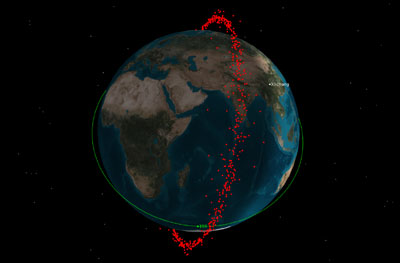Space preservation or space destruction?by Dale Armstrong
|
| The Chinese ASAT test highlighted by the Celestrak animation is the BRAVO of our era. It’s time to take the next step, and extend the ban on nuclear testing in space to include a ban on the testing of destructive anti-satellite weapons. |
Accordingly, the Celestrak animation juxtaposes an international Blue Team—represented by the ISS—with an insouciant Red Team, represented by the hundreds of pieces of Chinese space junk floating through LEO. The use of an animation to help muster international opinion against the Chinese in some ways mirrors the American attempt to create an internationally representative (anti-Soviet) Committee on the Peaceful Uses of Outer Space (COPUOS) in 1958. At that time, the American objective had been to minimize Soviet influence on the Committee in order to establish, internationally, an American reputation for seeking cooperation in outer space. As well, it had been to ensure that crucial satellite reconnaissance programs were not compromised in any way by an adverse international political climate. This, of course, stands in marked contrast to American isolation today, with respect to the prevention of an arms race in outer space (PAROS) at the Conference on Disarmament. And yet, really—as demonstrated by the Celestrak animation—it is still in America’s interest to try to prevent crucial reconnaissance programs from being compromised, not to mention the Shuttle, HST, and just about everything else in LEO.
Another way in which the dramatic animation recreates the 1950s is with respect to the concern over the atmospheric testing of hydrogen bombs. Just as the Chinese test scattered debris throughout LEO, so the fallout from America’s 1954 BRAVO test unexpectedly headed south, where it blanketed the nearby islands of Rongelap, Rongerik, Uterik, and, as well, a Japanese fishing trawler, the Lucky Dragon. Thereafter, atomic fallout became a global concern. Atomic testing reached its post-war peak in 1957–58, and in a surprise move aimed at capturing international sentiment, the Soviets offered to stop testing their nuclear weapons if the United States would do the same. This led to an extended period of discussion that—spurred by the Cuban Missile Crisis—resulted in the 1963 Partial Test Ban Treaty, which outlawed the atmospheric, oceanic, and space testing of nuclear weapons.
Could the Chinese ASAT test spur the creation of a Space Environment Treaty? If next year, on the eve of the Olympics, a piece of Chinese ASAT debris punctured the ISS, a Soyuz, or the Shuttle, the negative publicity could well produce another Tiananmen-like protest. For that matter, the debris could threaten China’s own taikonauts!
There has been rampant speculation as to why the Chinese conducted their test. Was it simply to see if they could do it? Was it to see if anyone noticed? Or was it in response to the recent US National Space Policy? The 2006 National Space Policy was certainly a very firmly worded document, but American doctrine has always revolved around the words: deceive, deny, degrade, disrupt, and destroy—in that order—when it comes to satellites. In other words, satellite destruction, for good reason, has always been regarded as an action of last resort. Russia, the United States, and now China have, variously, demonstrated co-orbital and kinetic energy ASAT weapons. It’s time to stop that type of testing.
The Chinese ASAT test highlighted by the Celestrak animation is the BRAVO of our era. It’s time to take the next step, and extend the ban on nuclear testing in space to include a ban on the testing of destructive anti-satellite weapons. As no country really wants to destroy orbiting satellites, it’s better to re-align the space race now, by putting the emphasis on environmental preservation. Technological virtuosity knows no limits; for the moment, at least, lets make do with space weapons that are only able to deceive, deny, degrade, and disrupt!
